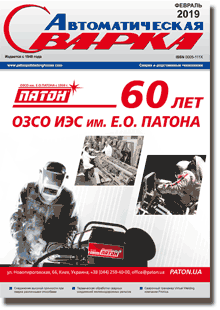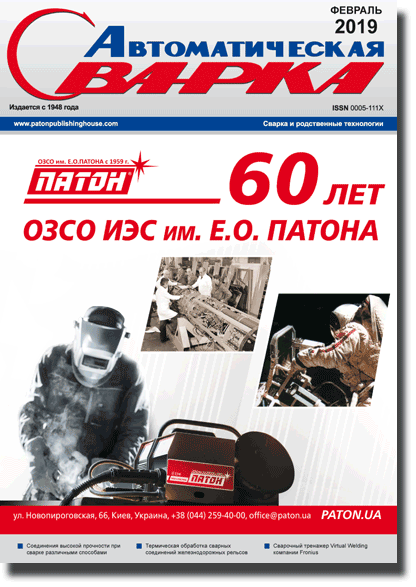| 2019 №02 (05) |
DOI of Article 10.15407/as2019.02.06 |
2019 №02 (07) |

Avtomaticheskaya Svarka (Automatic Welding), #2, 2019, pp. 43-50
Methods of evaluation of increase of fatigue resistance in butt welded joints of low-carbon steels after high-frequency mechanical peening
V. A. Degtyarev
S. Pisarenko Institute for Problems of Strength of the NAS of Ukraine. 2 Timiryazevskaya Str., 01014, Kyiv, Ukraine E-mail: degtyarev@ipp.kiev.ua
There was investigated an effect of modes of high-frequency mechanical peening on increase of fatigue resistance of butt welded joints of steel ST3sp (killed). Different technology of sample preparation for investigation allowed determining that quantitative contribution in rise of fatigue limit of welded joints, residual compression stresses, deformation hardening of surface layer of a groove formed after peening of narrow zone of weld fusion with base metal, and change of stress concentration after mechanical peening makes 57, 37 and 6 %, respectively. It is shown that there is a correlation between the groove depth and depth of plastically deformed layer of material. The procedure was proposed for determination of the fatigue limits of butt welded joints after different modes of peening on groove depth and plastically deformed layer of material, using the experimental data of microhardness measurement as well as the change of amplitude of osculation of working tool in the investigated range. A depth of groove was determined depending on speed of high-frequency mechanical peening and amplitude of working tool oscillation as well as change of sample fatigue limit due to different technology of their manufacture. It is shown that increase of peening speed independent on working tool osculation amplitude promotes decrease of efficiency of improvement of welded joint fatigue resistance and at 0.4 m/min speed the fatigue limit from deformation hardening and total effect of all factors typical for high-frequency mechanical peening rises by 11 and 26 %, respectively. 14 Ref., 3 Tabl., 7 Fig.
Keywords: welded joint, fatigue limit, groove depth, speed of high-frequency mechanical peening, plastically deformed layer, microhardness
Received: 24.10.2018
Published: 24.01.2019
References
1. Roy, S., Fisher, J.W., Yen, B.T. (2003) Fatigue resistance of welded details enhanced by ultrasonic impact treatment (UIT). Int. J. Fatigue, 25, 1239–1247. https://doi.org/10.1016/S0142-1123(03)00151-82. Wang, T., Wang, D, Huo, L., Zang, Y. (2008) Discussion on fatigue design of welded joints enhanced by ultrasonic peening treatment (UPT). Ibid., 4, 1–7.
3. Zhao, X., Wang, D., Huo, L. (2011) Analysis of the S–N curves of welded joints enhanced by ultrasonic peening treatment. Materials and Design, 32(1), 88–96. https://doi.org/10.1016/j.matdes.2010.06.030
4. Marguis, G. (2010) Failure modes and fatigue strength of improved HSS welds. Engineering Fracture Mechanics, 77, 2051–2062. https://doi.org/10.1016/j.engfracmech.2010.03.034
5. Trufyakov, V.I., Statnikov, E.Sh., Mikheev, P.P., Kuzmenko, A.Z. (1998) The efficiency of ultrasonic impact treatment for improving the fatigue strength of welded joints. Intern. Inst. of Welding. IIW Doc. XIII-1745–98, 12.
6. Lobanov, L.M., Kirian, V.I., Knysh, V.V., Prokopenko, G.I. (2006) Improvement of fatigue resistance of welded joints in metal structures by high-frequency mechanical peening (Review). The Paton Welding J., 9, 2–8.
7. Mikheev, P.P., Nedoseka, A.Ya., Parkhomenko, I.V. (1984) Efficiency of application of ultrasonic impact treatment for improvement of fatigue resistance of welded joints. Avtomatich. Svarka, 3, 4–7 [in Russian].
8. Degtyarev, V.A. (2011) Evaluation of effect of high-frequency mechanical peening modes of welded joints on their fatigue resistance. Problemy Prochnosti, 2, 61–70 [in Russian].
9. Prokopenko, G.I., Kleiman, Ya.I., Kozlov, O.V. et al. (2002) Device for ultrasonic peening treatment of metals. Pat. 47536, Ukraine [in Ukrainian].
10. Knysh, V.V., Solovej, S.A., Bogajchuk, I.L. (2011) Optimisation of the process of strengthening of welded joints of 09G2S steel by high-frequency mechanical peening. The Paton Welding J., 5, 20–24.
11. GOST 9450–76: Measurement of microhardness by indentation of diamond cone. Introd. 01.01.1977 [in Russian].
12. Serensen, S.V., Kogaev, V.P., Shnejderovich, R.M. (1975) Load-carrying capacity and strength design of machine parts. Moscow, Mashinostroenie [in Russian].
13. Manson, S.S., Muralidharam, U. (1987) Fatigue life prediction in bending from axial fatigue information. Fatigue Fract. Eng. Mater. Struct., 9(5), 357–372. https://doi.org/10.1111/j.1460-2695.1987.tb00462.x
14. Kirian, V.I., Knysh, V.V. (2008) High-frequency mechanical peening of welded joints of metal structures. Svarochn. Proizvodstvo, 11, 36–41 [in Russian].
The cost of subscription/purchase order journals or individual articles
| Journal/Currency | Annual Set | 1 issue printed |
1 issue |
one article |
| TPWJ/USD | 384 $ | 32 $ | 26 $ | 13 $ |
| TPWJ/EUR | 348 € | 29 € | 24 € | 12 € |
| TPWJ/UAH | 7200 UAH | 600 UAH | 600 UAH | 280 UAH |
| AS/UAH | 1800 UAH | 300 UAH | 300 UAH | 150 UAH |
| AS/USD | 192 $ | 32 $ | 26 $ | 13 $ |
| AS/EUR | 180 € | 30 € | 25 € | 12 € |
| SEM/UAH | 1200 UAH | 300 UAH | 300 UAH | 150 UAH |
| SEM/USD | 128 $ | 32 $ | 26 $ | 13 $ |
| SEM/EUR | 120 € | 30 € | 25 € | 12 € |
| TDNK/UAH | 1200 UAH | 300 UAH | 300 UAH | 150 UAH |
| TDNK/USD | 128 $ | 32 $ | 26 $ | 13 $ |
| TDNK/EUR | 120 € | 30 € | 25 € | 15 € |
AS = «Automatic Welding» - 6 issues per year;
TPWJ = «PATON WELDING JOURNAL» - 12 issues per year;
SEM = «Electrometallurgy Today» - 4 issues per year;
TDNK = «Technical Diagnostics and Non-Destructive Testing» - 4 issues per year.





